Delhi, the capital of India, is home to several magnificent forts that stand as testaments to its rich and tumultuous history. The forts in Delhi showcase the architectural grandeur and strategic importance of the city. The most iconic fort in Delhi is the Red Fort (Lal Qila), a UNESCO World Heritage Site. Another significant fort is the Purana Qila (Old Fort), possibly built on the site of the ancient city of Indraprastha.These forts, with their imposing walls, grand gateways, and historic significance, are key attractions for those interested in Delhi’s heritage and history.
10 Famous Forts In Delhi
If you love to explore and get enlightened by the rich historical and cultural heritage of Delhi, visit the 10 best forts in Delhi:
1. Red Fort
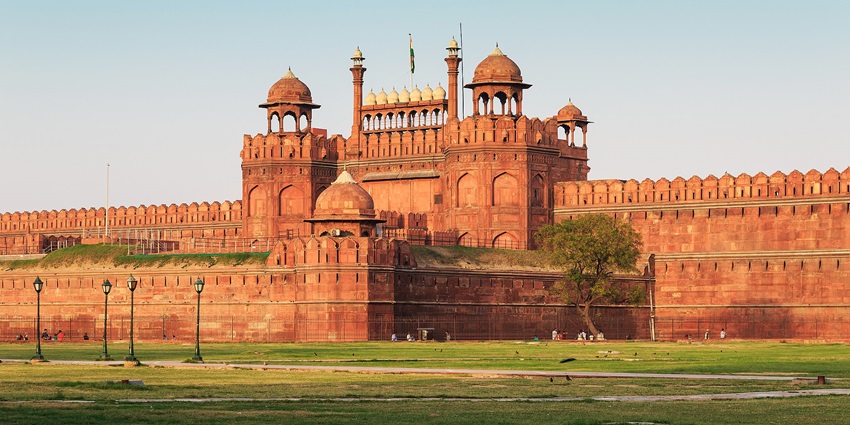
Photo: A.Savin / Wikimedia Commons
The Red Fort, a UNESCO World Heritage Site, is one of the most historical forts in Delhi. The Prime Minister hoists the national flag on Independence Day here. Apart from the Lahori Gate, visitors can explore the Diwan-i-Aam (Hall of Public Audience) and the Diwan-i-Khas (Hall of Private Audience), known for its stunningly intricate design. Moreover, the Red Fort also houses the Rang Mahal, the palace of the royal women, and the Mumtaz Mahal, now part of the Red Fort Archaeological Museum. The fort’s architecture blends Persian, Timurid, and Indian styles, making it a masterpiece of Mughal artistry.
Entry Fee: ₹50 per person for Indian Citizens and ₹250 per person for Foreign Nationals
Timings: 9:30 AM to 4:30 PM ( Closed on Mondays and national holidays )
Suggested Read: Places To Visit Near Red Fort To Experience The Architectural Wonders
2. Purana Qila
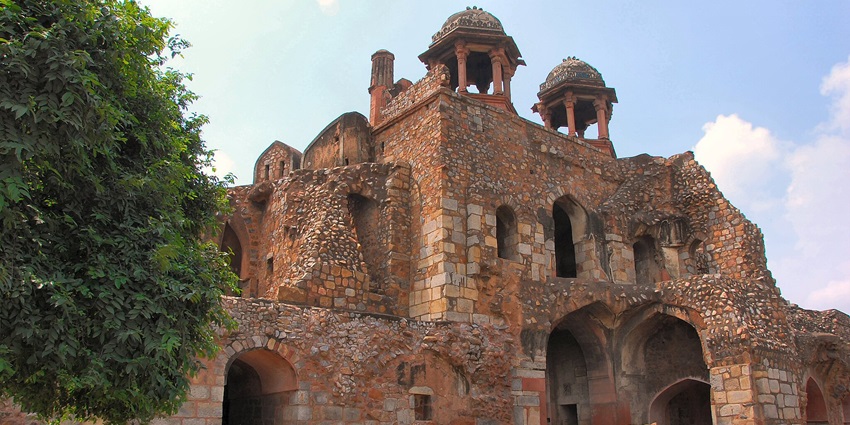
Photo: Russ Bowling / Wikimedia Commons
Located near the India Gate and Pragati Maidan in the heart of Delhi, Purana Qila is one of the oldest among Delhi forts. The fort’s architecture reflects a blend of Mughal and Afghan styles, with massive walls, impressive gateways, and intricate detailing. The main structures within the fort include the Qila-i-Kuhna Mosque and the Sher Mandal, a double-storied octagonal tower. The fort also hosts a sound and light show that narrates Delhi’s history. Therefore, the place offers a fascinating glimpse into Delhi’s layered history and is a must-visit for anyone interested in India’s rich cultural heritage.
Entry Fee: ₹30 per person for Indian Nationals and ₹300 per person for Foreign Nationals
Timings: 7 AM to 5 PM
3. Tughlaqabad Fort
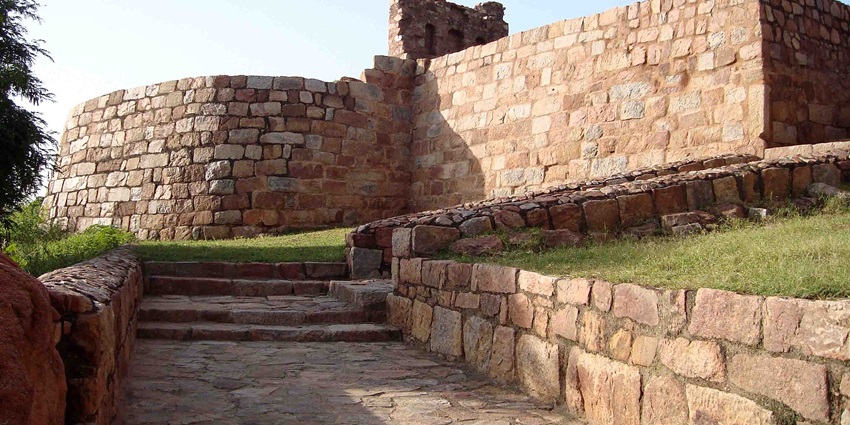
Photo: Anupamg / Wikimedia Commons
Tughlaqabad Fort is a ruined fort in Delhi, India, that was built by Ghiyasuddin Tughlaq, the founder of the Tughlaq dynasty. According to a legend, the fort was abandoned soon after it was built due to a curse by the Sufi saint Nizamuddin Auliya, who was displeased with Ghiyasuddin Tughlaq. Therefore, the fort was deserted and never fully inhabited, contributing to its rapid decline into ruins. Architecturally, the fort contains massive walls and bastions, Ghiyasuddin Tughlaq’s Tomb, underground passages and baolis/step wells.
Entry Fee: ₹25 per person for Indian citizens and ₹300 per person for Foreign nationals
Timings: 7 AM to 5 PM
Suggested Read: Top Places To Visit In Delhi For Every Type Of Traveller
4. Siri Fort
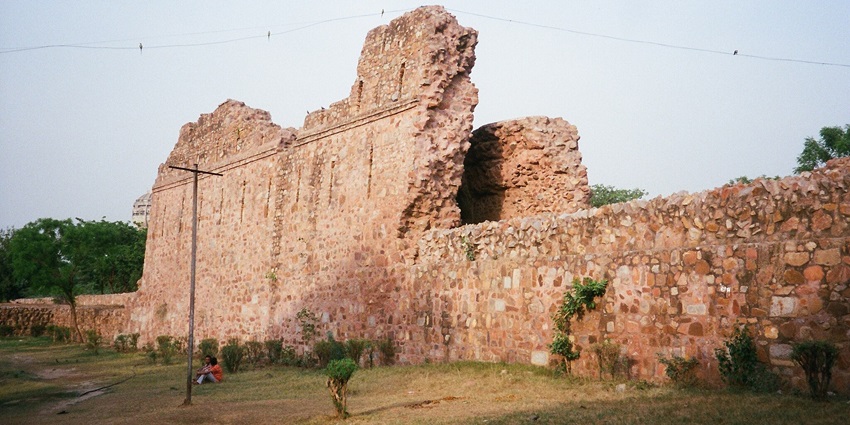
Photo: Nvvchar. / Wikimedia Commons
Part of the city of Siri, which was the second of the seven ancient cities of Delhi, Siri Fort is one of the oldest forts in Delhi. In ruins, the fort’s architecture back then can be characterised by thick stone walls, bastions, and gates. The walls were built with rubble masonry and were once 10 to 15 metres high. Adjacent to the ruins is the Siri Fort Auditorium, one of Delhi’s most prominent cultural centres. The auditorium hosts various events, including film screenings, theatre performances, and music concerts. Therefore, Siri Fort offers a glimpse into the early mediaeval history of Delhi and the architectural legacy of the Khilji dynasty.
Location: South Delhi, near the modern-day Hauz Khas
Nearest Metro Station: Green Park station on the yellow line of Delhi Metro
5. Feroz Shah Kotla
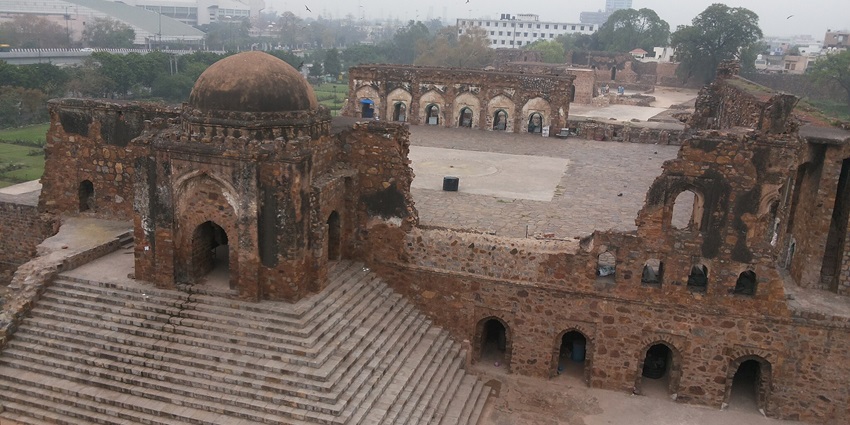
Photo: Kanujajo / Wikimedia Commons
Feroz Shah Kotla fort is known for its Ashokan Pillar, which was transported from Topra in Haryana. The fort’s ruins include the Jama Masjid, one of the oldest surviving mosques in Delhi, and the remnants of palaces and baolis (stepwells). The fort’s architecture is a typical example of the Tughlaq style, with robust construction and simple, functional designs. The 13-metre-high polished sandstone pillar( Ashokan Pillar) is one of the oldest historical artefacts in Delhi and bears inscriptions in Brahmi script, reflecting the Buddhist teachings of Emperor Ashoka.
Timings: 7 AM to 6 PM
Entry Fee: ₹25 per person for Indian citizens and ₹300 per person for Foreign nationals
Suggested Read: Things To Do In Delhi In One Day For A Memorable Trip
6. Qila Rai Pithora
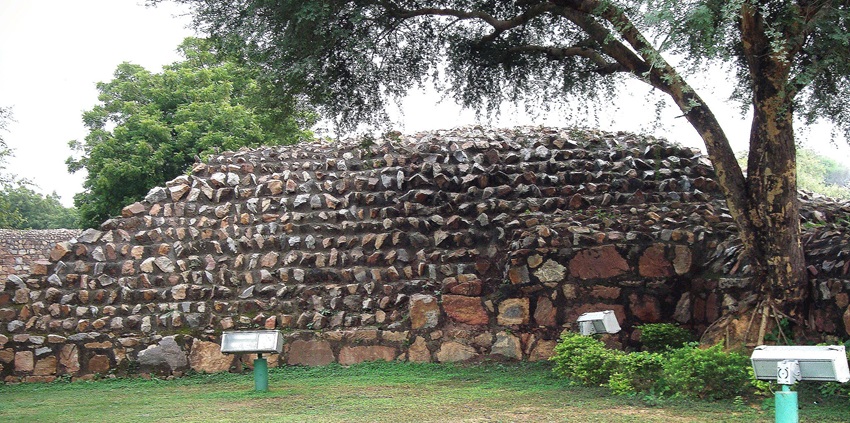
Photo: Anupamg / Wikimedia Commons
It was originally built by the Rajput king Prithviraj Chauhan, also known as Rai Pithora. This fort marks the expansion of Lal Kot, the original fortification established by the Tomar dynasty, and represents the historical legacy of early mediaeval Delhi. Qila Rai Pithora offers a glimpse into the early mediaeval history of Delhi and the legacy of the Rajput king Prithviraj Chauhan. Although much of the fort is in ruins, it remains a significant historical landmark and a reminder of Delhi’s ancient past. While much of the fort has been lost to time, it remains an important symbol of Delhi’s pre-Islamic history.
Location: Saket and Mehrauli areas of South Delhi
Nearest Metro Station: Qutub Minar Metro Station on the Yellow Line of the Delhi Metro
7. Salimgarh Fort
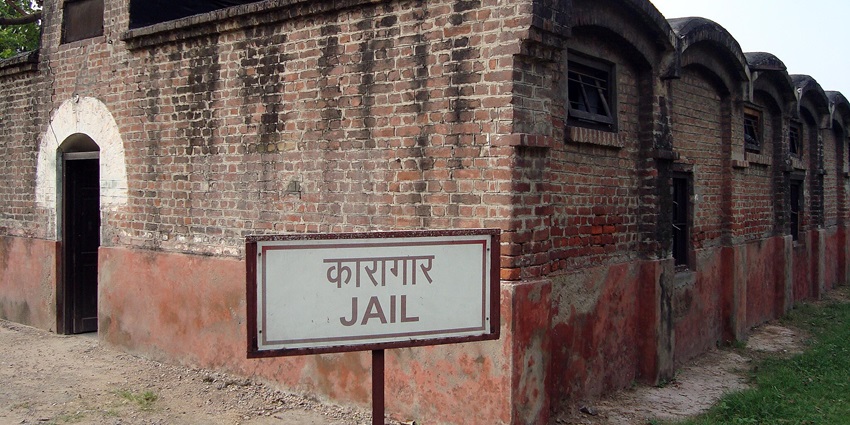
Photo: Anupamg / Wikimedia Commons
Salimgarh Fort was built by Islam Shah Suri, the son of Sher Shah Suri, in 1546. It later became part of the Mughal complex when Shah Jahan built the Red Fort nearby. The fort was used as a prison during the British period, including housing political prisoners during the Indian freedom struggle. It is now part of the Red Fort complex and is accessible through the Red Fort.
Timings: 9:30 AM to 4:30 PM (closed on Mondays)
Entry Fee: ₹35 per person for Indian Citizens and ₹550 per person for Foreign Nationals (including entry to the Red Fort)
Suggested Read: Places To Visit In Delhi For Fun To Enjoy A Thrilling Time
8. Adilabad Fort
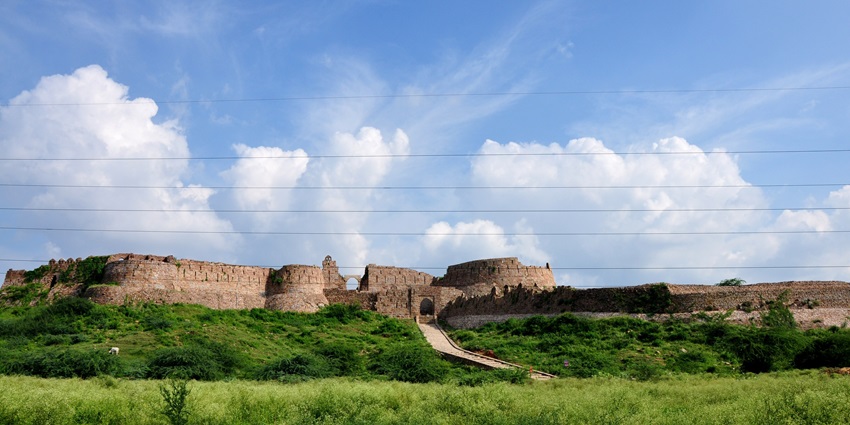
Photo: Sabyasachi Dasgupta / Wikimedia Commons
Adilabad Fort was built by Sultan Muhammad bin Tughlaq in the 14th century. This smaller, more secluded fort was constructed as an extension of Tughlaqabad but was designed as a personal retreat for the Sultan. The fort’s architecture mirrors the robust defensive style of its larger counterpart, with thick walls, strong bastions, and a strategically elevated location. Despite its modest size, Adilabad was an integral part of the Tughlaq dynasty’s network of defences. Today, it remains mostly in ruins, but its secluded atmosphere and the panoramic views of the surrounding landscape make it a hidden gem for history enthusiasts and explorers.
Timings: 7 AM to 5 PM
Nearest Metro Station: Tughlakabad Metro Station on the Violet Line of the Delhi Metro
9. Jahanpanah Fort
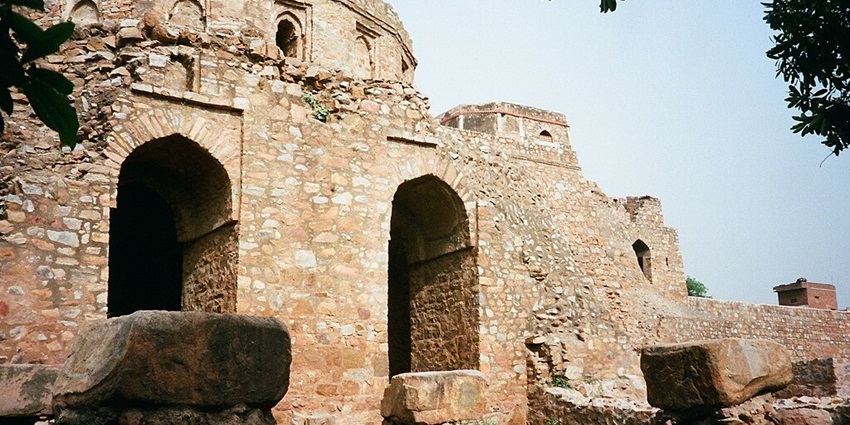
Photo: Nvvchar / Wikimedia Commons
Jahanpanah Fort was part of the Sultan’s ambitious plan to unite Delhi’s scattered settlements into a single fortified city. Also known as the “Refuge of the World,” Jahanpanah aimed to protect the inhabitants from frequent Mongol invasions. Though much of it has been lost to time, remnants of Jahanpanah’s walls can still be seen in areas like Bijay Mandal and Begampur. The fort’s walls were designed with defence in mind, fortified with bastions and gateways that marked the entrances. The fort remains an important historical site, reflecting the Sultan’s architectural and strategic vision.
Timings: 6 AM to 6 PM
Nearest Metro Station: Hauz Khas Metro Station on the Yellow Line and Magenta Line of the Delhi Metro
Suggested Read: Top Places To Visit In Delhi On Sunday To Explore The Capital City
10. Lal Kot
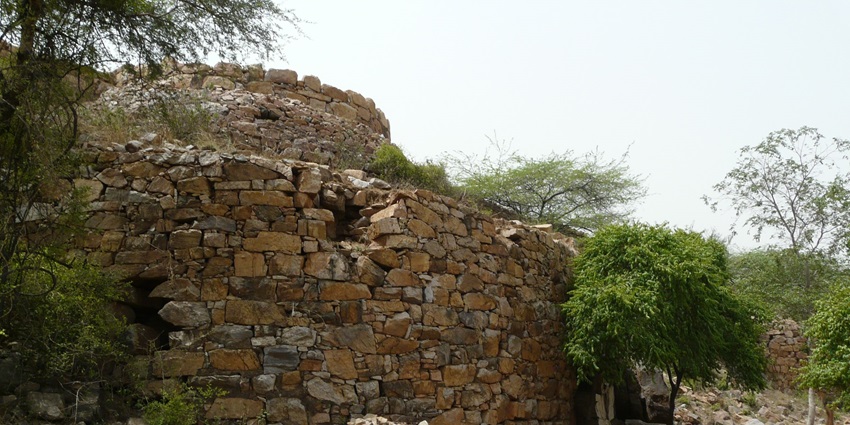
Photo: Varun Shiv Kapur / Wikimedia Commons
Lal Kot, the original fortified city of Delhi, was built by Anangpal Tomar II in the 11th century. Located in the Mehrauli area, Lal Kot is the precursor to Qila Rai Pithora and represents the earliest known fortification of Delhi. The Tomar dynasty, which ruled over the area, constructed this fort to defend against invaders and to establish their reign over the region. Lal Kot’s thick stone walls and bastions demonstrate early Indian military architecture. The surviving ruins, interspersed with modern developments, offer a sense of Delhi’s ancient past, marking the city’s first step toward becoming a capital of empires.
Timings: 6 AM to 6 PM daily
Nearest Metro Station: Qutub Minar Metro Station on the Yellow Line of the Delhi Metro
Forts in Delhi, with its unique legacy, contribute to the rich cultural and historical heritage for explorers and history enthusiasts. From the iconic Red Fort, a symbol of India’s independence and Mughal grandeur, to the ancient ruins of Purana Qila and the strategic Tughlaqabad Fort, these structures reflect Delhi’s strategic importance and architectural evolution. Book a trip with TripXL to explore these historically significant sites in Delhi.
Cover Photo: Slyronit / Wikimedia Commons


 WhatsApp
WhatsApp
 Twitter
Twitter









